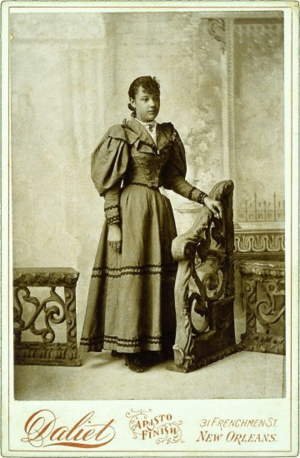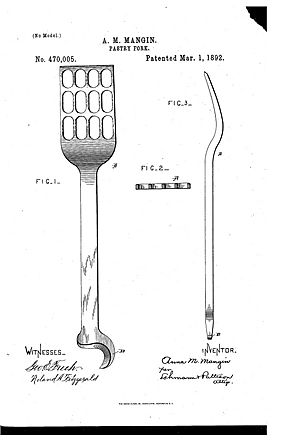Anna Mangin facts for kids
Anna M. Mangin (born October 1844 – died March 1, 1931) was an amazing American inventor, teacher, and caterer. She also worked for women's rights. In 1891, she invented a special kitchen tool she called a pastry fork. This was different from the small fork you might use to eat pastries.
Contents
Early Life and Education
Anna M. Mangin was born in October 1844 in Louisiana. Her birth name was Anna Matilda Barker. When she got married in 1877, she said her parents were Jacob Barker and P. Shelton. Jacob Barker was a rich farmer and businessman.
It's thought that Anna came to Nantucket, Massachusetts with the help of Jacob Barker and others. She was taken in by Elizabeth S. Ray and her husband, Abraham M. Nahar. They adopted Anna, and she became known as Annie Mattie Nahar.
In 1845, Abraham and Elizabeth Nahar, along with others, signed a petition. They wanted to end segregation in Nantucket's public schools. Segregation meant that Black and white children had to go to separate schools. Because of their efforts, the schools became integrated. This meant Annie Mattie could go to school with all children at the South School. People who knew her said she was a "young woman of rare character."
Becoming a Teacher
When the American Civil War started, Annie Nahar was a student at Nantucket High School. A Quaker activist named Anna Gardner asked for teachers to go South. These teachers would help educate formerly enslaved people, known as "freedmen."
In June 1864, Annie left Nantucket for New Orleans. She taught school there for four years. She worked with the Freedmen's Bureau, an organization that helped freed slaves. After that, she moved to San Antonio, Texas.
In 1870, Annie returned to New Orleans. She became the principal of the Coliseum School. By 1877, she was the principal of one of the McDonogh Schools. These schools were set up to provide free education for all children, no matter their race.
Around this time, she met Andrew Fitch Mangin. He was an African-American man who worked as a coachman and teamster. People said he was very smart.
On August 17, 1877, Andrew and Annie got married in New Orleans. They then moved to New York City. Annie started a new job as a cook and caterer. Andrew began a hauling and moving business with his brothers. On January 7, 1879, Annie gave birth to their only child, a son also named Andrew.
Life in Woodside, New York
Soon after moving North, Andrew Mangin bought land in Woodside, New York. He built a small house there for his family. He continued his freight business until 1895. Then, he opened a coal yard on their property.
Anna Mangin kept her catering business. She also taught some of the Black children in Woodside.
Anna Mangin's Famous Invention: The Pastry Fork
Anna M. Mangin made a very important invention for homes in the 1800s: the pastry fork.
Her husband, Andrew, said that Anna first thought of a simpler way to make pastry. She described her idea for an improved pastry fork to him. Andrew said he could "see that fork just as plain as I see you now." He went to his tool shed and carved a model of the fork from wood. Once Anna approved it, Andrew had a stronger model made from metal. Anna Mangin received the official patent for her pastry fork on March 1, 1892.
The pastry fork could do many things! It was used to:
- Beat eggs
- Thicken foods
- Make mashed potatoes
- Create salad dressings
- Most importantly, knead pastry dough
The fork had a curved part at the top of the handle. Anna called this the "cutter or trimmer for pie crust."
Kneading dough by hand can be very hard work. It can make your arms tired and sore. Also, if dough isn't mixed well, it won't rise properly. This can make baked goods dense and not fully cooked. Anna's pastry fork made this process much easier and helped people make better pastries. Her invention even helped lead to the electric mixers we use today!
Exhibition and Later Years
Anna Mangin's pastry fork was shown at the New York Afro-American Exhibit. This was part of the World's Columbian Exposition in 1893. The exhibit was in the women's building, and Anna had a special corner to show off her invention.
Anna Mangin was also very active in her community. For example, in 1907, she helped with a charity fair. This fair supported a home for working girls in Brooklyn, New York. Mrs. Mangin helped run a booth called the Star Booth.
After Andrew Mangin passed away in 1907, Anna and their son closed the coal yard. They stayed on the property until 1925. Then, her son, Andrew Mangin, Jr., bought a chicken farm in Brookfield, Connecticut. Anna and her son moved there.
Anna Mangin died in a hospital in Danbury, Connecticut on March 1, 1931. She was buried in the Mangin family plot in Evergreens Cemetery.
See also
- List of African-American inventors and scientists
- Timeline of United States inventions



